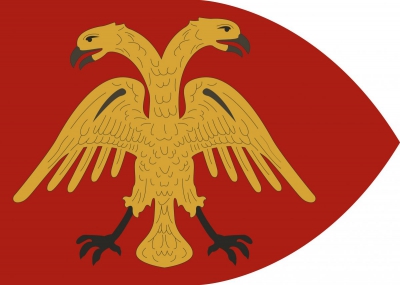Mehmed II (Ottoman Turkish: , romanized: Memed-i sn; Turkish: II. Mehmed, pronounced [icindi mehmed]; 30 March 1432 3 May 1481), commonly known as Mehmed the Conqueror (Ottoman Turkish: , romanized: Eb'l-fet, lit.'the Father of Conquest'; Turkish: Fatih Sultan Mehmet), was an Ottoman sultan who ruled from August 1444 to September 1446, and then later from February 1451 to May 1481. In Mehmed II's first reign, he defeated the crusade led by John Hunyadi after the Hungarian incursions into his country broke the conditions of the truce Peace of Szeged. When Mehmed II ascended the throne again in 1451 he strengthened the Ottoman navy and made preparations to attack Constantinople. At the age of 21, he conquered Constantinople (modern-day Istanbul) and brought an end to the Byzantine Empire.
After the conquest Mehmed claimed the title Caesar of the Roman Empire (Ottoman Turkish: , romanized: Qayser-i Rm), based on the fact that Constantinople had been the seat and capital of the surviving Eastern Roman Empire since its consecration in 330 AD by Emperor Constantine I. The claim was only recognized by the Patriarchate of Constantinople. Nonetheless, Mehmed II viewed the Ottoman state as a continuation of the Roman Empire for the remainder of his life, seeing himself as "continuing" the Empire rather than "replacing" it.
Mehmed continued his conquests in Anatolia with its reunification and in Southeast Europe as far west as Bosnia. At home he made many political and social reforms, encouraged the arts and sciences, and by the end of his reign, his rebuilding program had changed Constantinople into a thriving imperial capital. He is considered a hero in modern-day Turkey and parts of the wider Muslim world. Among other things, Istanbul's Fatih district, Fatih Sultan Mehmet Bridge and Fatih Mosque are named after him.
The Empire of Trebizond, or Trapezuntine Empire, was a monarchy and one of three successor rump states of the Byzantine Empire that flourished during the 13th through to the 15th century, consisting of the far northeastern corner of Anatolia (the Pontus) and the southern Crimea. The empire was formed in 1204 with the help of the Georgian queen Tamar after the Georgian expedition in Chaldia and Paphlagonia, commanded by Alexios Komnenos a few weeks before the sack of Constantinople. Alexios later declared himself Emperor and established himself in Trebizond (modern day Trabzon, Turkey). Alexios and David Komnenos, grandsons and last male descendants of deposed Emperor Andronikos I Komnenos, pressed their claims as "Roman emperors" against Byzantine Emperor Alexios V Doukas. The later Byzantine emperors, as well as Byzantine authors, such as George Pachymeres, Nicephorus Gregoras and to some extent Trapezuntines such as John Lazaropoulos and Basilios Bessarion, regarded the emperors of Trebizond as the "princes of the Lazes", while the possession of these "princes" was also called Lazica. Thus from the point of view of the Byzantine writers connected with the Laskaris and later with the Palaiologos dynasties, the rulers of Trebizond were not emperors.After the crusaders of the Fourth Crusade overthrew Alexios V and established the Latin Empire, the Empire of Trebizond became one of three Byzantine successor states to claim the imperial throne, alongside the Empire of Nicaea under the Laskaris family and the Despotate of Epirus under a branch of the Angelos family. The ensuing wars saw the Empire of Thessalonica, the imperial government that sprung from Epirus, collapse following conflicts with Nicaea and Bulgaria and the final recapture of Constantinople by the Empire of Nicaea in 1261. Despite the Nicaean reconquest of Constantinople, the Emperors of Trebizond continued to style themselves as "Roman emperors" for two decades and continued to press their claim on the Imperial throne. Emperor John II of Trebizond officially gave up the Trapezuntine claim to the Roman imperial title and Constantinople itself 21 years after the Nicaeans recaptured the city, altering his imperial title from "Emperor and Autocrat of the Romans" to "Emperor and Autocrat of all the East, Iberia and Perateia".The Trapezuntine monarchy survived the longest among the Byzantine successor states. The Despotate of Epirus had ceased to contest the Byzantine throne even before the Nicaean reconquest and was briefly occupied by the restored Byzantine Empire c. 1340, thereafter becoming a Serbian dependency later inherited by Italians, ultimately falling to the Ottoman Empire in 1479. Whilst the Empire of Nicaea had restored the Byzantine Empire through restoring control of the capital, it ended in 1453 with the conquest of Constantinople by the Ottomans. Trebizond lasted until 1461 when the Ottoman Sultan Mehmed II conquered it after a month-long siege and took its ruler and his family into captivity. The Crimean Principality of Theodoro, an offshoot of Trebizond, lasted another 14 years, falling to the Ottomans in 1475.

1461Aug, 15
The Empire of Trebizond surrenders to the forces of Sultan Mehmed II. This is regarded by some historians as the real end of the Byzantine Empire. Emperor David is exiled and later murdered.
Choose Another Date
Events on 1461
- 2Feb
Battle of Mortimer's Cross
Wars of the Roses: The Battle of Mortimer's Cross is fought in Herefordshire, England. - 4Mar
Henry VI of England
Wars of the Roses in England: Lancastrian King Henry VI is deposed by his House of York cousin, who then becomes King Edward IV. - 29Mar
Battle of Towton
Wars of the Roses: Battle of Towton: Edward of York defeats Queen Margaret to become King Edward IV of England. - 7Aug
Rebellion of Cao Qin
The Ming dynasty Chinese military general Cao Qin stages a coup against the Tianshun Emperor.

 English
English  español
español  français
français  português
português  русский
русский  العربية
العربية  简体中文
简体中文 